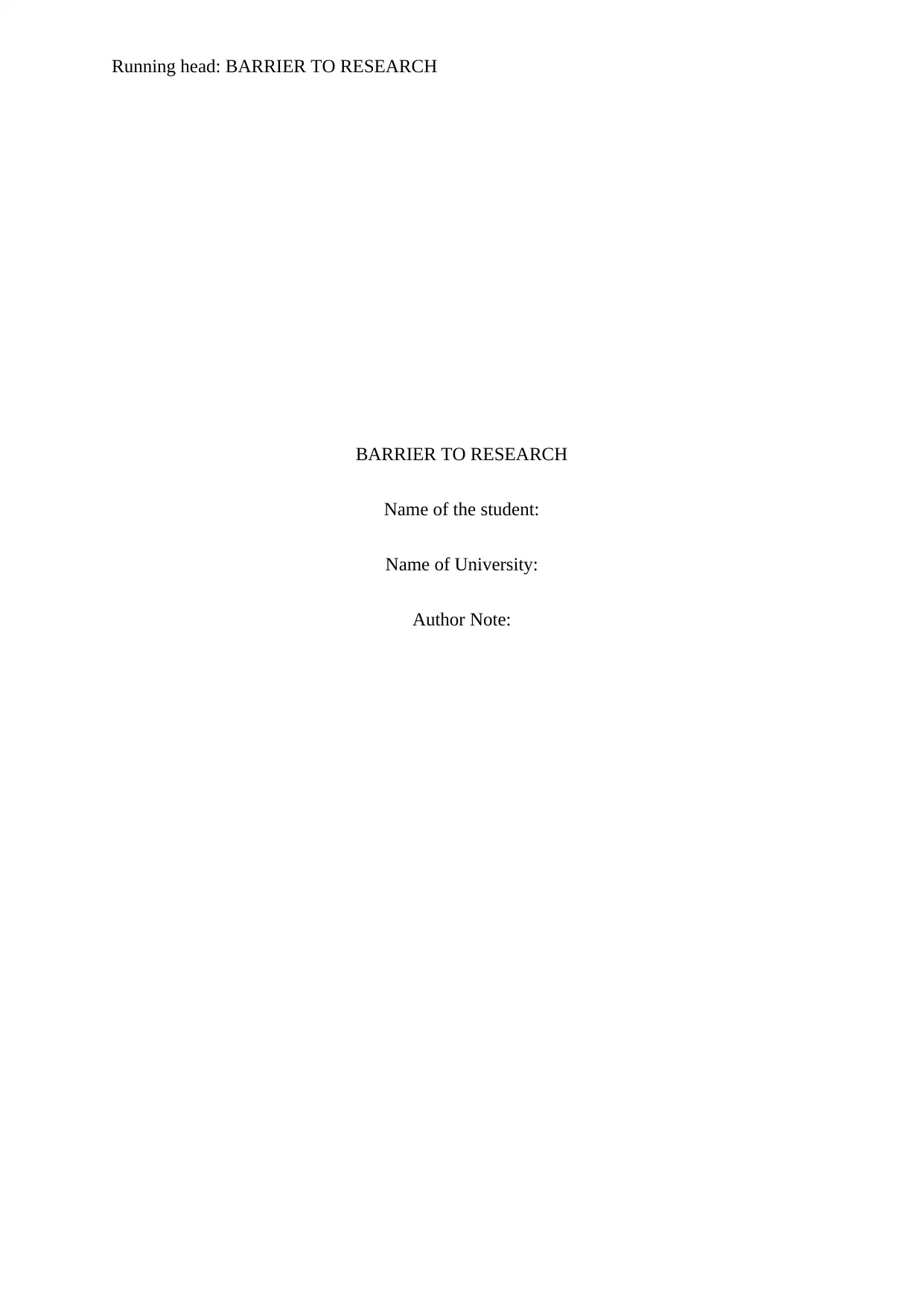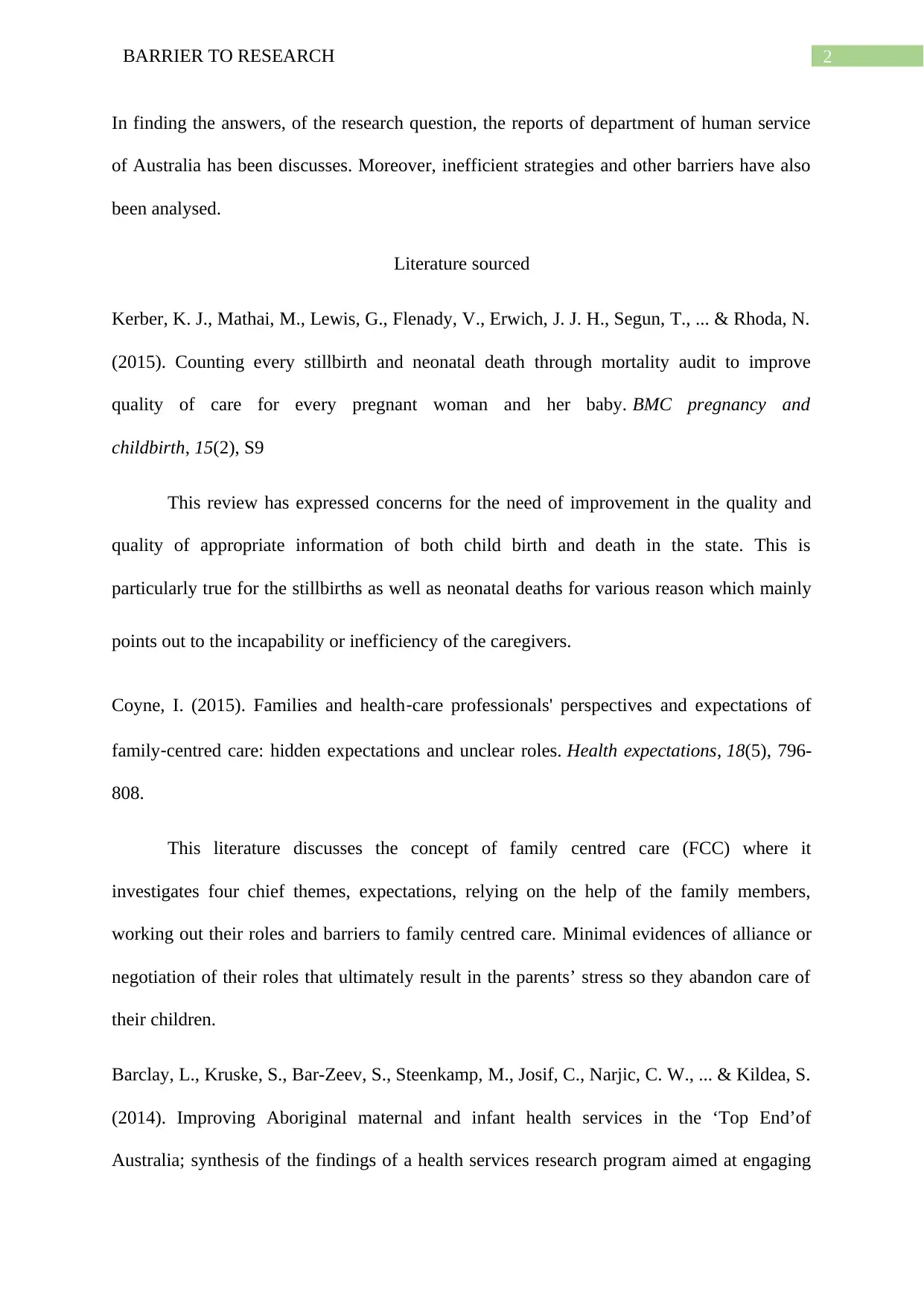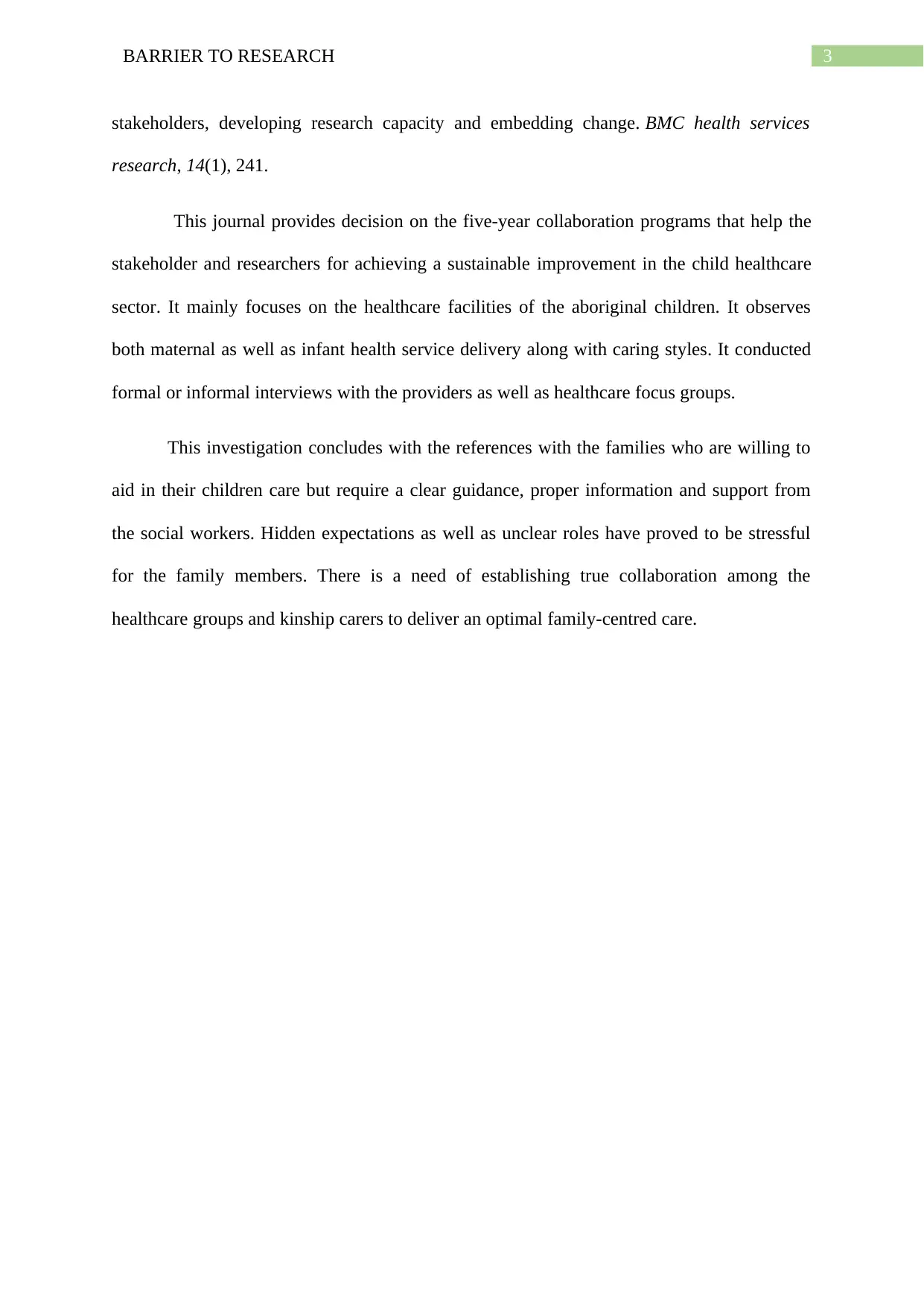Key Barriers in the Child Protection System for Kinship Carers
VerifiedAdded on 2021/04/21
|5
|1059
|69
Report
AI Summary
This report investigates the key barriers in Australia's child protection system, specifically concerning the treatment of kinship carers. It addresses the research problem identified from the Victorian Ombudsman's report, which highlights the neglect of disabled and ill children by their kinship carers. The report explores the financial and psychological challenges these carers face, often grandparents or family members, who lack sufficient resources to provide adequate care. The literature review examines the lack of financial and governmental support, the impact of complex health issues, and the need for improved collaboration between healthcare providers and kinship carers. The report analyzes the implications of these barriers, emphasizing the need for better support systems to ensure the well-being of vulnerable children and their carers.

Running head: BARRIER TO RESEARCH
BARRIER TO RESEARCH
Name of the student:
Name of University:
Author Note:
BARRIER TO RESEARCH
Name of the student:
Name of University:
Author Note:
Paraphrase This Document
Need a fresh take? Get an instant paraphrase of this document with our AI Paraphraser

1BARRIER TO RESEARCH
What are the key barriers in the child protection system in the treatment of kinship
carers Australia?
The chief research problem of this work has been identified from the report of
Victorian ombudsman (OVO) Sustainability of Victoria’s child protection system put at risk
by treatment of kinship carers (2018). The main purpose of this report is to investigate the
reasons of neglecting the disabled and ill children by their kinship carers. The report has been
investigating the root cause of negligence based on which the government will be providing
financial help to the kinship carers. These carers are chiefly the members of the family of the
ailing children or the social groups that have revealed an alarming weakness in the national
child protection system. These kinship carers are the typically the grandparents or other
members of family who do not have ample income to protect the children during their
ailments (Humanservices.gov.au, 2018). They have taken these sick children during the time
of crisis or family violation and abusive, irresponsible parents. On the other hands these
people do not have opportunity for other forms of out-of-home care. The ill children with
their complex health issues or behavioural considerations have been placed with unqualified
kinship carers with lesser income that compromise their recovery.
This review of the literatures discloses the fact that these kinship careers do not have
financial or psychological stretch to assist these children and they do not get ample financial
backups from the health care organizations or any kind of support from the Government.
Research problem: treatment of the sick children by the kinship carers.
Research question: What are the key barriers in the child protection system in the treatment
of kinship carers Australia?
What are the key barriers in the child protection system in the treatment of kinship
carers Australia?
The chief research problem of this work has been identified from the report of
Victorian ombudsman (OVO) Sustainability of Victoria’s child protection system put at risk
by treatment of kinship carers (2018). The main purpose of this report is to investigate the
reasons of neglecting the disabled and ill children by their kinship carers. The report has been
investigating the root cause of negligence based on which the government will be providing
financial help to the kinship carers. These carers are chiefly the members of the family of the
ailing children or the social groups that have revealed an alarming weakness in the national
child protection system. These kinship carers are the typically the grandparents or other
members of family who do not have ample income to protect the children during their
ailments (Humanservices.gov.au, 2018). They have taken these sick children during the time
of crisis or family violation and abusive, irresponsible parents. On the other hands these
people do not have opportunity for other forms of out-of-home care. The ill children with
their complex health issues or behavioural considerations have been placed with unqualified
kinship carers with lesser income that compromise their recovery.
This review of the literatures discloses the fact that these kinship careers do not have
financial or psychological stretch to assist these children and they do not get ample financial
backups from the health care organizations or any kind of support from the Government.
Research problem: treatment of the sick children by the kinship carers.
Research question: What are the key barriers in the child protection system in the treatment
of kinship carers Australia?

2BARRIER TO RESEARCH
In finding the answers, of the research question, the reports of department of human service
of Australia has been discusses. Moreover, inefficient strategies and other barriers have also
been analysed.
Literature sourced
Kerber, K. J., Mathai, M., Lewis, G., Flenady, V., Erwich, J. J. H., Segun, T., ... & Rhoda, N.
(2015). Counting every stillbirth and neonatal death through mortality audit to improve
quality of care for every pregnant woman and her baby. BMC pregnancy and
childbirth, 15(2), S9
This review has expressed concerns for the need of improvement in the quality and
quality of appropriate information of both child birth and death in the state. This is
particularly true for the stillbirths as well as neonatal deaths for various reason which mainly
points out to the incapability or inefficiency of the caregivers.
Coyne, I. (2015). Families and health‐care professionals' perspectives and expectations of
family‐centred care: hidden expectations and unclear roles. Health expectations, 18(5), 796-
808.
This literature discusses the concept of family centred care (FCC) where it
investigates four chief themes, expectations, relying on the help of the family members,
working out their roles and barriers to family centred care. Minimal evidences of alliance or
negotiation of their roles that ultimately result in the parents’ stress so they abandon care of
their children.
Barclay, L., Kruske, S., Bar-Zeev, S., Steenkamp, M., Josif, C., Narjic, C. W., ... & Kildea, S.
(2014). Improving Aboriginal maternal and infant health services in the ‘Top End’of
Australia; synthesis of the findings of a health services research program aimed at engaging
In finding the answers, of the research question, the reports of department of human service
of Australia has been discusses. Moreover, inefficient strategies and other barriers have also
been analysed.
Literature sourced
Kerber, K. J., Mathai, M., Lewis, G., Flenady, V., Erwich, J. J. H., Segun, T., ... & Rhoda, N.
(2015). Counting every stillbirth and neonatal death through mortality audit to improve
quality of care for every pregnant woman and her baby. BMC pregnancy and
childbirth, 15(2), S9
This review has expressed concerns for the need of improvement in the quality and
quality of appropriate information of both child birth and death in the state. This is
particularly true for the stillbirths as well as neonatal deaths for various reason which mainly
points out to the incapability or inefficiency of the caregivers.
Coyne, I. (2015). Families and health‐care professionals' perspectives and expectations of
family‐centred care: hidden expectations and unclear roles. Health expectations, 18(5), 796-
808.
This literature discusses the concept of family centred care (FCC) where it
investigates four chief themes, expectations, relying on the help of the family members,
working out their roles and barriers to family centred care. Minimal evidences of alliance or
negotiation of their roles that ultimately result in the parents’ stress so they abandon care of
their children.
Barclay, L., Kruske, S., Bar-Zeev, S., Steenkamp, M., Josif, C., Narjic, C. W., ... & Kildea, S.
(2014). Improving Aboriginal maternal and infant health services in the ‘Top End’of
Australia; synthesis of the findings of a health services research program aimed at engaging
⊘ This is a preview!⊘
Do you want full access?
Subscribe today to unlock all pages.

Trusted by 1+ million students worldwide

3BARRIER TO RESEARCH
stakeholders, developing research capacity and embedding change. BMC health services
research, 14(1), 241.
This journal provides decision on the five-year collaboration programs that help the
stakeholder and researchers for achieving a sustainable improvement in the child healthcare
sector. It mainly focuses on the healthcare facilities of the aboriginal children. It observes
both maternal as well as infant health service delivery along with caring styles. It conducted
formal or informal interviews with the providers as well as healthcare focus groups.
This investigation concludes with the references with the families who are willing to
aid in their children care but require a clear guidance, proper information and support from
the social workers. Hidden expectations as well as unclear roles have proved to be stressful
for the family members. There is a need of establishing true collaboration among the
healthcare groups and kinship carers to deliver an optimal family-centred care.
stakeholders, developing research capacity and embedding change. BMC health services
research, 14(1), 241.
This journal provides decision on the five-year collaboration programs that help the
stakeholder and researchers for achieving a sustainable improvement in the child healthcare
sector. It mainly focuses on the healthcare facilities of the aboriginal children. It observes
both maternal as well as infant health service delivery along with caring styles. It conducted
formal or informal interviews with the providers as well as healthcare focus groups.
This investigation concludes with the references with the families who are willing to
aid in their children care but require a clear guidance, proper information and support from
the social workers. Hidden expectations as well as unclear roles have proved to be stressful
for the family members. There is a need of establishing true collaboration among the
healthcare groups and kinship carers to deliver an optimal family-centred care.
Paraphrase This Document
Need a fresh take? Get an instant paraphrase of this document with our AI Paraphraser

4BARRIER TO RESEARCH
References:
Barclay, L., Kruske, S., Bar-Zeev, S., Steenkamp, M., Josif, C., Narjic, C. W., ... & Kildea, S.
(2014). Improving Aboriginal maternal and infant health services in the ‘Top End’of
Australia; synthesis of the findings of a health services research program aimed at
engaging stakeholders, developing research capacity and embedding change. BMC
health services research, 14(1), 241.
Coyne, I. (2015). Families and health‐care professionals' perspectives and expectations of
family‐centred care: hidden expectations and unclear roles. Health
expectations, 18(5), 796-808.
Humanservices.gov.au. (2018). Australian Government Department of Human
Services. Humanservices.gov.au. Retrieved 9 March 2018, from
https://www.humanservices.gov.au/
Kerber, K. J., Mathai, M., Lewis, G., Flenady, V., Erwich, J. J. H., Segun, T., ... & Rhoda, N.
(2015). Counting every stillbirth and neonatal death through mortality audit to
improve quality of care for every pregnant woman and her baby. BMC pregnancy and
childbirth, 15(2), S9.
Ombudsman.vic.gov.au. (2018). Retrieved 9 March 2018, from
https://www.ombudsman.vic.gov.au/News/Media-Releases/Media-Alerts/Treatment-
of-kinship-carers
References:
Barclay, L., Kruske, S., Bar-Zeev, S., Steenkamp, M., Josif, C., Narjic, C. W., ... & Kildea, S.
(2014). Improving Aboriginal maternal and infant health services in the ‘Top End’of
Australia; synthesis of the findings of a health services research program aimed at
engaging stakeholders, developing research capacity and embedding change. BMC
health services research, 14(1), 241.
Coyne, I. (2015). Families and health‐care professionals' perspectives and expectations of
family‐centred care: hidden expectations and unclear roles. Health
expectations, 18(5), 796-808.
Humanservices.gov.au. (2018). Australian Government Department of Human
Services. Humanservices.gov.au. Retrieved 9 March 2018, from
https://www.humanservices.gov.au/
Kerber, K. J., Mathai, M., Lewis, G., Flenady, V., Erwich, J. J. H., Segun, T., ... & Rhoda, N.
(2015). Counting every stillbirth and neonatal death through mortality audit to
improve quality of care for every pregnant woman and her baby. BMC pregnancy and
childbirth, 15(2), S9.
Ombudsman.vic.gov.au. (2018). Retrieved 9 March 2018, from
https://www.ombudsman.vic.gov.au/News/Media-Releases/Media-Alerts/Treatment-
of-kinship-carers
1 out of 5
Your All-in-One AI-Powered Toolkit for Academic Success.
+13062052269
info@desklib.com
Available 24*7 on WhatsApp / Email
![[object Object]](/_next/static/media/star-bottom.7253800d.svg)
Unlock your academic potential
Copyright © 2020–2025 A2Z Services. All Rights Reserved. Developed and managed by ZUCOL.


